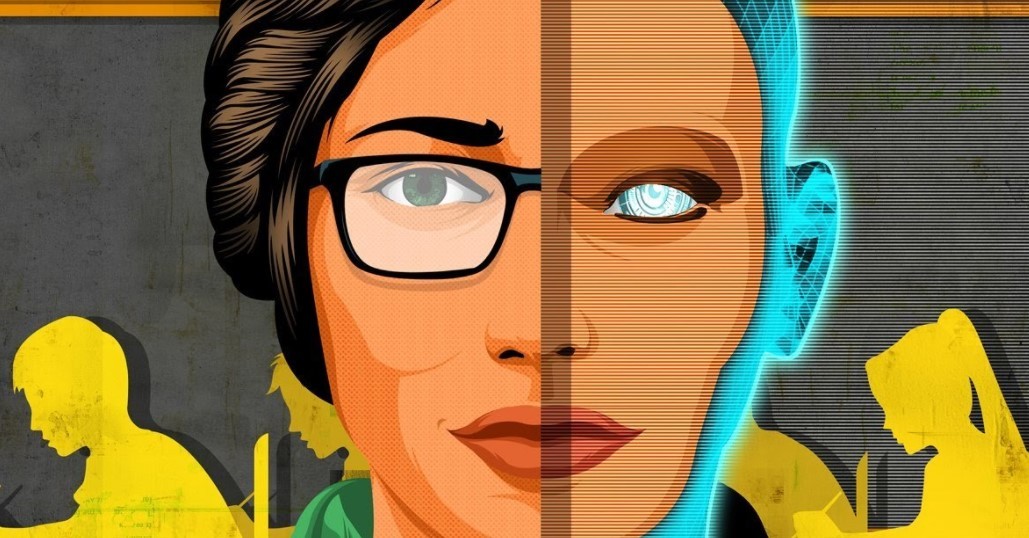

Thanks to the technological process and modern innovations, each of us can get information from another part of the globe, start studying in another country or be in a classroom without leaving home, just by wearing a VR helmet. Machine intelligence is increasingly being incorporated into education, such as smart textbooks, learning platforms, or robotic teachers. But can technology, for all its uniqueness, replace humans? Can we say that in the future a live teacher will become a kind of atavism and will be completely replaced by an intelligent robot? In this article, we will try to find answers to these questions.
Let’s start with the fact that even the most advanced technology has not yet learned to recognize mood, freely generate emotions and subjectively approach the motivation of each student. The individual psychological approach remains one of the main differences between humans and machines.
When dealing with information, at first glance, artificial intelligence comes out ahead. In the blink of an eye it is possible to get an answer to any question or to use resources from anywhere on the planet. For example, it is possible to visit electronic libraries of leading foreign universities, while being in another country. Or, artificial intelligence can pick up a networking topic for presentation. However, if you look at it from a different angle, it turns out that no machine will create a clearly structured study plan for you using a ready-made search result. Whereas a teacher collects and processes information throughout, improving the delivery methods and the essence of the material.
The most popular of the electronic ones is Google Translator, which has been on the market for ten years. The translation algorithm is improving thanks not so much to technical progress as to user activity. They make adjustments and clarify the meaning of words. It is essentially a neural network based on the principles of crowdsourcing, where the human factor is as important as possible.
There is already everything for electronic translators to develop rapidly. Applications based on machine learning will already be able to translate jargon, phrases, and proverbs adequately. For example, Google Translator is great at translating languages that are similar in structure and sentence structure. For example, when translating from Spanish to English and vice versa. However, it does not translate well in languages with very different grammars. Russian and English are structurally different, which is why we feel that Google Translator is sloppy. But even if you receive a poor translation of your article, you can have it proofread by an essay service. Specialists will check your essay text for literacy and offer the correct version.
Artificial intelligence and machine learning are now trending and gaining momentum. This means that the likelihood of creating simultaneous interpretation technology that can replace humans is increasing. In addition to electronic translators, computers and smartphones will develop headsets with simultaneous interpretation. It will be possible to download and install several languages in such a device, for example, before a trip abroad.
Many industry niches, from marketing to education, are undergoing notable changes in IT. Much of this metamorphosis also depends on the human factor, or rather the generation that is at its peak. The current generation is the millennials. They demand a completely new approach and attitude to themselves, and in all areas that surround us. They are a cranky customer who has already seen a lot, but expects even tastier and cooler things to come.
And it is necessary to surprise not just for fun, but with benefits and specifics. For example, to personalize the product or service to the extent that the final consumer thinks that everything revolves around him and for him.
At this point, there are already platforms that track which types of assignments a student does worse and give them exactly those to progress on. You can also set repetition of what you’ve learned at a certain interval so you don’t lose vocabulary. Machine learning allows you to understand which tasks are too difficult and require additional knowledge. With time, the educational digital platform will be able to notice how satisfied the student is with the lesson – how often he smiled, what was the timbre of his voice. By getting this kind of data – you can make a breakthrough in learning.
The next stage of learning is likely to be getting an education through virtual reality. Wearing a special helmet, it will be possible to communicate with a person from anywhere on the planet as if they were sitting next to you.
Robots will also be used for learning. Machine learning will make robots into teachers who can surround a person everywhere, like a governess.
It is hard to say how quickly our predictions will come true, because recently no one has even heard of machine learning, and now everyone is using applications built on the principles of machine learning. Perhaps the next generation of young people in schools and universities will see a robot librarian or be occupied in a VR helmet in history class. And students can use artificial intelligence to get a cheap business essay.
This website uses cookies.